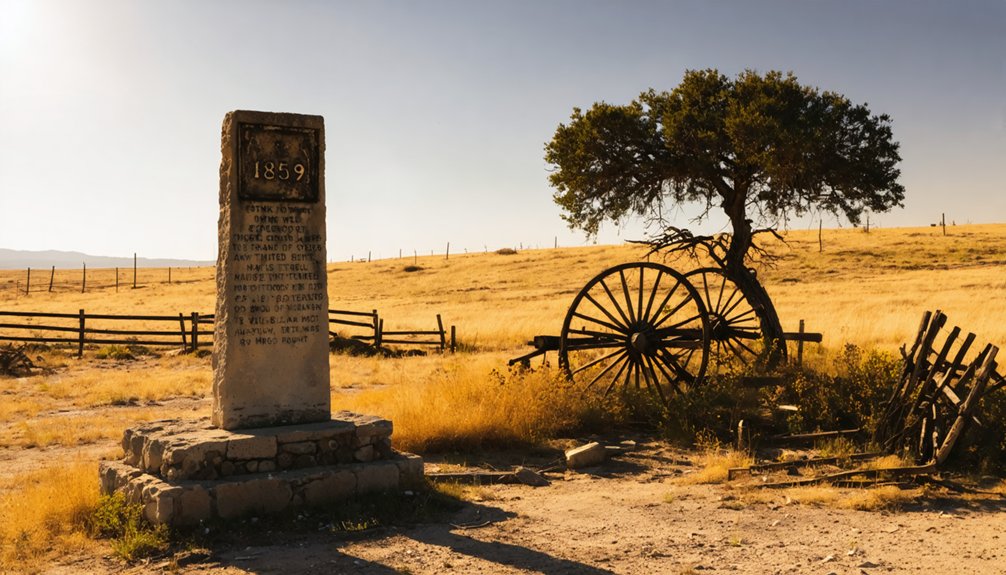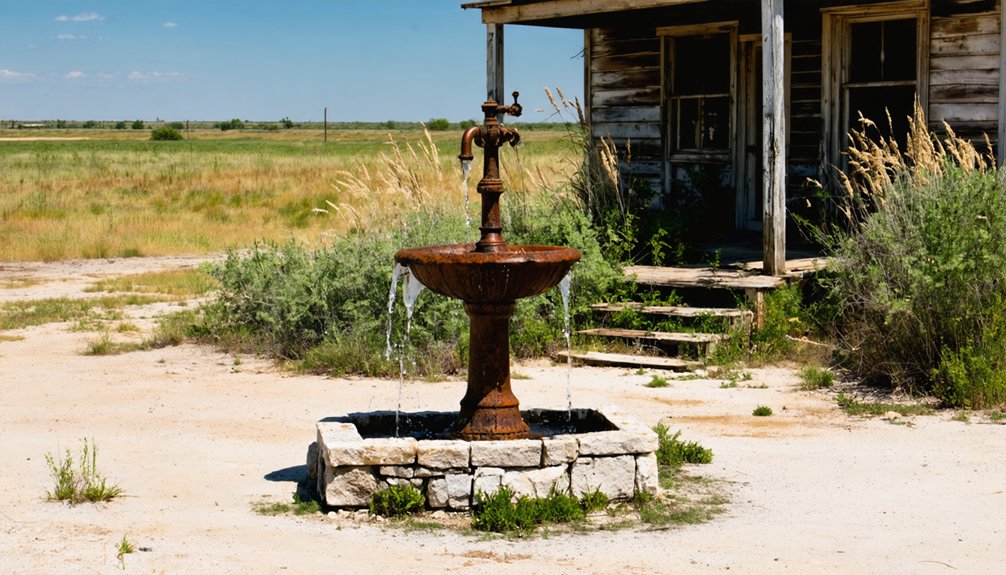You’ll find New Fountain’s ghost town remains in Medina County, Texas, where German immigrants established a thriving settlement in 1846. The community flourished as a stagecoach stop along the San Antonio-El Paso Road, complete with a Methodist church, Masonic lodge, and post office by 1860. Despite reaching 400 residents by 1896, the town declined after missing railroad connections and losing its post office in 1914. Today, only a historic cemetery and scattered ruins reveal its frontier legacy.
Key Takeaways
- New Fountain became a ghost town after declining from 400 residents in 1896 due to economic hardship and lack of rail access.
- Originally established in 1846, the settlement thrived as a stagecoach stop along the San Antonio-El Paso Road by 1860.
- The closure of the post office in 1914 marked a turning point in the community’s decline and abandonment.
- Historical remnants include the New Fountain United Methodist Church and two cemeteries containing 19th-century grave markers.
- The town’s collapse stemmed from deteriorating infrastructure, water scarcity, and young residents leaving for urban opportunities.
Origins and Early Settlement
A strategic relocation in 1846 marked the founding of New Fountain, Texas, when colonists from the depleted settlement of Vandenburg moved four miles downstream along Verde Creek. The settler motivations were clear – they needed a reliable water source after their original springs ran dry.
New Fountain’s birth came from necessity, as settlers abandoned Vandenburg in 1846 to find fresh water downstream along Verde Creek.
Under Henri Castro’s empresario grant, the new settlement attracted immigrants from Germany and Alsace Lorraine, establishing a vibrant frontier community. A Methodist church and lodge established in 1860 helped form the backbone of the growing settlement. The town established a post office in 1857, becoming the fourth such facility in Medina County.
You’ll find that cultural influences from European traditions shaped New Fountain’s early development, as these determined pioneers built their lives in the fertile Medina River valley. The discovery of a dependable spring inspired the settlement’s name and secured its future.
Positioned 1.8 miles west of Quihi and 5.6 miles east-northeast of Hondo, New Fountain became an essential colonization point in Medina County’s emerging landscape.
Transportation and Communication Hub
By 1860, New Fountain had emerged as an important transportation nexus along the San Antonio-El Paso Road, serving as both a strategic stagecoach stop and a critical communication point for the Texas frontier.
You’d find the town’s fourth post office operating here from 1857 to 1914, connecting settlers through essential communication networks while supporting stagecoach routes with rest, refueling, and lodging services.
Though New Fountain never gained direct rail access, the town maintained its significance through the region’s evolving transportation landscape, similar to how Pearl Brewing Company would later shape transportation in San Antonio.
The presence of Verde Creek’s springs guaranteed reliable water sources for travelers and stagecoach operations.
While nearby railroad development gradually diminished stagecoach travel’s importance, New Fountain’s role as a transportation hub left an indelible mark on Medina County’s frontier development.
The site’s historical significance mirrors the mission of volunteer preservationists who work to protect transportation heritage across Texas.
Agricultural Innovation and Economic Growth
While New Fountain thrived as a transportation hub, its economic foundation rested firmly in agriculture, with cotton emerging as the dominant crop across Medina County’s fertile landscapes. The early German settlers established a strong community presence in the region’s farming development.
You’d find innovative farming practices transforming the region, as agricultural machinery like seed drills and improved plowing tools boosted productivity. The local mill, established by 1860, revolutionized grain processing and supported crop diversification efforts. Local farmers embraced innovation when they agreed to plant 200 acres of cotton if Fredrich Muennink would construct his gin.
- Cotton fields stretched across the horizon, their white bolls gleaming under the Texas sun
- Modern irrigation systems snaked through farmland, drawing life-giving water from the Medina River
- Steam-powered mills churned with the rhythmic processing of local grains
- Inventive farmers testing new implements across their fields, pushing agricultural boundaries
However, nature challenged this progress when the devastating boll weevil infestation of the early 1900s disrupted cotton production, forcing economic adaptation.
Community Life and Social Infrastructure
Life in New Fountain centered around a vibrant social infrastructure that united European immigrants through shared institutions and cultural bonds.
You’d find community gatherings focused on the Methodist church, established in 1858, which served as the heart of local activities and worship. The Masonic lodge, built by 1860, provided an additional venue for social networks and fraternal connections. Historical maps from 1954 help preserve the memory of these important community landmarks.
The town’s stagecoach stop connected you to the broader Texas landscape, bringing news, mail, and travelers along the San Antonio-El Paso Road. Like the once-bustling town of Red River Station, it served as a vital transportation hub.
You’d experience a rich blend of German and Alsatian heritage through local traditions, while the New Fountain School, established in 1876, fostered education and youth development.
These institutions created a tight-knit community where mutual support and shared values defined daily life.
The Path to Decline
New Fountain’s decline began as economic forces conspired against it, with the lack of rail access and water scarcity hampering its ability to compete with better-connected towns.
You’ll find that critical infrastructure gradually deteriorated, marked by the closure of the post office in 1914 and the eventual shutdown of agricultural facilities like the cotton gin and mill. Like many towns in Texas that lost two-thirds of residents, New Fountain experienced a dramatic exodus of its population.
The town’s population, which had reached 400 residents by 1896, steadily dwindled as people sought opportunities in neighboring communities with more robust economies and modern amenities.
Economic Forces Take Hold
As economic challenges intensified throughout the region, New Fountain began experiencing the telltale signs of decline that would ultimately seal its fate.
The town’s economic vulnerability became apparent as its dependence on a single industry left it exposed to market fluctuations. Investment stagnation took hold as construction projects ground to a halt and property values plummeted. Home prices across the region saw catastrophic drops, mirroring the pattern of other declining Texas towns.
- You’d see abandoned construction sites with weathered equipment standing silent against the Texas sky.
- You’d notice “For Sale” signs multiplying across town like wildflowers after a spring rain.
- You’d witness younger residents packing up their lives, leaving only empty storefronts behind.
- You’d observe rental properties sitting vacant, their reduced rates unable to attract new tenants.
The mounting pressure of rising interest rates and industry volatility only accelerated New Fountain’s downward spiral.
Infrastructure Slowly Deteriorates
The slow decay of New Fountain’s infrastructure marked the next phase of the town’s demise.
You’d have noticed the infrastructure neglect in every corner of the community, from crumbling roads to failing water systems. The harsh Texas climate accelerated the deterioration, while limited funding made maintenance challenges insurmountable for local authorities.
As public services declined, you’d have witnessed the town’s utilities becoming increasingly unreliable. Water loss from aging pipes, power outages, and deteriorating public facilities created a cascade of problems that drove more residents away.
The maintenance challenges proved too costly for New Fountain’s shrinking tax base, creating a vicious cycle of decline. The town’s remaining residents faced difficult choices as their once-vibrant community struggled to maintain even basic services.
Population Steadily Dwindles
While many rural Texas towns faced population decline in the late 20th century, New Fountain’s demographic spiral proved particularly dramatic.
You’ll find that population migration away from this once-vibrant community followed patterns seen across Texas’s High Plains, where more deaths than births combined with steady outward movement left towns struggling to maintain their identity.
- Young residents departed for urban opportunities, leaving aging populations behind
- Crucial services vanished as community numbers dropped below sustainable levels
- The Methodist church and post office closed, severing essential social connections
- Rural isolation intensified as neighboring communities also shrank
What you’re witnessing in New Fountain reflects broader regional trends, where the pull of metropolitan areas like Dallas-Fort Worth has systematically drawn residents away from agricultural communities, accelerating their transformation into ghost towns.
Historical Legacy and Modern Remnants

Today, you’ll find New Fountain’s most enduring landmark in the preserved Ebenezer Methodist Church, which has stood since 1858 as a symbol of the settlement’s religious foundations.
The church, along with its cemetery and the historic cotton gin site, represents one of the few remaining physical connections to this once-thriving German immigrant community.
These architectural remnants, combined with New Fountain’s pioneering role in Medina County’s agricultural development, cement its significance in Texas Hill Country history.
Preserved Church and Cemetery
Standing as a tribute to New Fountain’s pioneering spirit, the New Fountain United Methodist Church remains the primary preserved structure from this vanished Texas settlement. Founded in 1858 by Rev. John Schaper, this historical architecture stands as a symbol of the cultural heritage of early Texas settlers near Quihi in Medina County.
You’ll find these enduring remnants of New Fountain’s past:
- The church building with its original historical marker
- New Fountain Methodist Cemetery at 29.38724°N, -99.05866°W
- Masonic Springs Cemetery, located east of County Road 4526
- Grave markers dating back to the mid-19th century
The church and its cemeteries serve as the last physical links to New Fountain’s vibrant past, offering crucial insights into the community’s social fabric and religious foundations through preserved structures and burial records.
Settlement’s Lasting Historical Impact
Despite its transformation into a ghost town, New Fountain’s enduring legacy shapes Medina County’s historical narrative through significant economic and cultural contributions.
You’ll find its influence reflected in the pioneering establishment of one of the county’s first cotton gins, which revolutionized local agriculture and demonstrated early technological advancement with its tin roof and electric power.
The settlement’s cultural heritage remains evident through the German and Alsace-Lorraine immigrant contributions that defined its architectural style and farming practices.
As the site of the county’s fourth post office and an essential stagecoach stop, New Fountain played a significant role in developing regional communication and transportation networks.
Today, though largely abandoned, the town’s remaining structures and historical records continue to inform understanding of Texas Hill Country’s development.
Frequently Asked Questions
What Was the Average Annual Rainfall in New Fountain During Its Peak Years?
You’ll find the average rainfall was 25-30 inches annually, which impacted climate impact patterns and agricultural trends throughout the region’s peak development during the late 1800s and early 1900s.
Were There Any Notable Conflicts Between Settlers and Native Americans?
You’ll find settler conflicts in the region centered on Comanche raids and native resistance, with tribes defending their territories while settlers pushed west through Texas during the mid-1800s.
What Happened to the Descendants of the Original Settler Families?
You’ll find descendants scattered across Texas, particularly in Medina County towns like Quihi and Hondo, where they’ve preserved their family lineage through Methodist churches and settlement legacy through historical records.
Did New Fountain Experience Any Significant Natural Disasters During Its Existence?
Like footprints in shifting sands, records don’t show major disasters, though you’ll find that flood events near Verde Creek and drought impacts likely challenged New Fountain’s agricultural prosperity.
What Were the Typical Land Prices in New Fountain During the 1800S?
You’d find land value in the area ranged from cents to $5 per acre, with pricing trends showing gradual increases throughout the 1800s, especially for properties near springs or roads.
References
- https://en.wikipedia.org/wiki/New_Fountain
- https://www.youtube.com/watch?v=EcKNorOzxtk
- https://pastmaps.com/explore/us/texas/medina-county/new-fountain/hiking-exploration
- https://en.wikipedia.org/wiki/List_of_ghost_towns_in_Texas
- https://www.hmdb.org/m.asp?m=164359
- https://www.texasescapes.com/TexasHillCountryTowns/Quihi-Texas.htm
- https://www.tshaonline.org/handbook/entries/new-fountain-tx
- https://www.legendsofamerica.com/nm-fountainmurders/
- https://www.youtube.com/watch?v=phjUE19A8HM
- https://www.thc.texas.gov/public/upload/preserve/survey/highway/1-Meridian_Final-Report_All-text_compiled reduced.pdf



